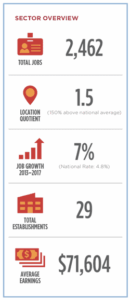Engineering Jobs Infographic
Our research shows that the average engineer earned $90,060 last year, and jobs for engineers grew by 4.0% during the 4-year period between 2013 and 2017. Another good indicator for the engineering profession – the location quotient (LQ) for engineering jobs is 1.30. The LQ is a statistical comparison of engineering employment to overall employment. A LQ of 1.30 means that engineers are employed at a rate 1.3 times that of all other workers. Given the importance of the engineering profession, it makes sense that engineers would have a higher rate of employment than the rest of the workforce.
Another interesting observation: of the 1.6 million engineers in the US, more than 820,000 have professional licenses. The significant number of engineers who have sought registration is a testament to the overall level of commitment and professionalism of this community. A century ago, registration did not exist and anyone could provide engineering services regardless of competency. In 1907, the State of Wyoming enacted the first engineering licensure law to protect the public health, safety, and welfare. Today, all fifty states regulate the practice of engineering to ensure public safety by granting Professional Engineers the authority to sign and seal engineering plans and offer their services to the public.
Job prospects vary by engineering discipline. We evaluated data from the US Bureau of Labor for a variety of technical majors. Employment for civil engineers is forecast to grow by 11 percent between 2016 and 2026. This growth represents 32,100 new jobs for civil engineers. Employment in the mechanical engineering field is expected to grow by 9% during this same period. Mechanical engineers can expect to see 25,300 new positions open up.
Petroleum engineers are seeing even more rapid job growth. The Bureau of Labor estimates a growth rate of 15 percent for the profession, which should expand the number of petroleum engineers by 4,900. A contributing factor in this industry, beyond the strong economy and explosive growth in hydrocarbons due to fracking is the large numbers of current petroleum engineers who are expecting to retire in the next decade. Oil prices, which fluctuate with time, will also affect employment levels. Demand for biomedical engineers is growing rapidly due to the aging baby boomers who are driving the demand for biomedical advances. The current prediction is at least 1,500 biomedical engineering jobs will open up over the next decade. This represents a growth rate of 7 percent, which is equal to the average growth rate for all jobs. The fastest growing engineering occupations are predicted to be found in biomedical, environmental, industrial, mining, nuclear, and petroleum engineering fields.
Environmental engineers use their engineering expertise to prevent, control and remediate chemical and biological hazards to the environment. The public’s strong interest in preserving the quality of our air, rivers, and streams ensures that the environmental engineering profession will grow at a rate of about 8 percent; an increase of approximately 4,400 jobs for environmental engineers.



Great infographic on engineering jobs.
Thanks for sharing. I read many of your blog posts, cool, your blog is very good.